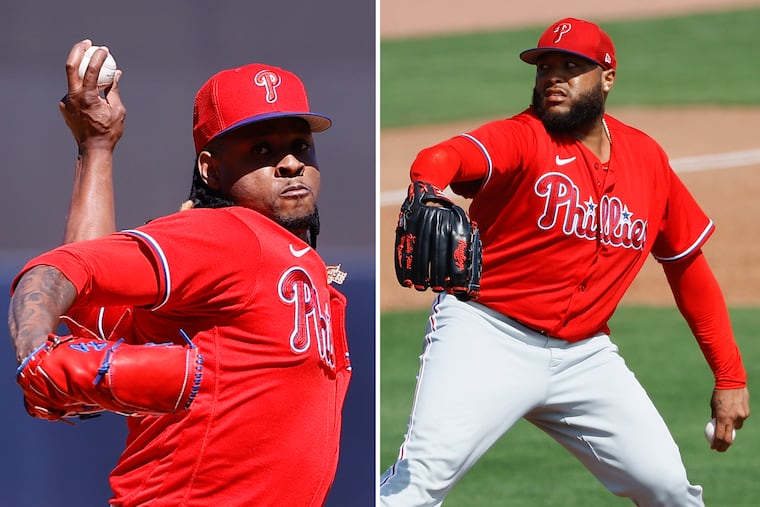Phillies counting on helping Gregory Soto like they did José Alvarado to form 1-2 lefty punch
The new duo topped 100 mph more than any other lefties last season. Improving Soto’s control will be a key for the Phillies bullpen.

CLEARWATER, Fla. — Before Gregory Soto was traded to the Phillies in early January, he used to watch José Alvarado’s outings on TV. He was a fan from afar. As it turns out, Alvarado was also a fan of his.
“He’s a warrior,” Alvarado said of Soto. “He isn’t afraid to be aggressive. That’s what I like about him. He’s going to help us win.”
“I know he throws harder than I do,” Soto said of Alvarado. “That’s some good motivation for me.”
When the Phillies acquired Soto, it didn’t take long for the Alvarado comparisons to come rolling in. The two pitchers combined for 81% of the 100-plus mph pitches thrown by all lefties in the regular season last year. But they have both pointed out some key differences that will make them even tougher for opposing hitters to face.
Soto has a lower arm slot than Alvarado’s higher one. They only throw two pitches in common — a sinker and a four-seam fastball. Soto throws a slider and a changeup, too, while Alvarado’s arsenal features a cutter and a curveball.
“It’ll be like a 1-2 punch,” Alvarado said. “I can get into a game first, or he can get into a game first and I can go after him. And then we have Seranthony [Domínguez], who also throws really hard. I think he’s going to be a key piece for us.”
Alvarado and Soto are linked not just because of their velocity, but also because of their control issues. Alvarado struggled to locate his pitches for most of his career, but after a brief stint in triple-A Lehigh Valley last season, he returned to the Phillies as a new pitcher. After walking 18 batters in 26⅔ innings in the first half of 2022, he walked just six in 24⅓ in the second half.
Part of this change was due to his work with a mental skills coach, but part of it was because he rediscovered his cutter when he was at Lehigh Valley. It became a legitimate out pitch for him, and a key to his success down the stretch.
» READ MORE: Injuries have trimmed Phillies’ margin for error. Zack Wheeler and Aaron Nola are again the keys.
Alvarado’s ability to not just throw hard but throw and locate was something Soto admired about him. Soto walked batters at a 14.5% clip in 2021 with the Tigers, and 12.9% in 2022. Nevertheless, the Phillies are optimistic that they can help Soto take a similar trajectory as Alvarado.
“For him, I think it’s just about walking fewer guys by planning our pitches, and giving us room in the strike zone to throw pitches in the strike zone,” said pitching coach Caleb Cotham. “His stuff is nasty. So, call it maybe a little rebalance of his portfolio and pitch usage. We want to shuffle maybe this pitch over that pitch. Just getting dialed into lefty-righty plan, pre-two strikes and two-strike plans, and letting him be himself inside of that.
“It’s about looking at what’s worked and figuring out how we keep his strengths his strengths. Which fastball is better to lefties or righties? How do we get his slider back to a little more of what it was a couple of years ago? We’re just opening up his options to finish guys.”
Having two hard-throwing lefties is only as good as their ability to locate. Alvarado has continued to prove that his command woes are a thing of the past. Whether Soto can get there remains to be seen. But if he does, the two lefties will be a lethal combination.
“Obviously, the stuff is off the charts,” Cotham said of Soto. “An incredible talent. [He and Alvarado] are two different looks, but if both of them are throwing strikes, it’s a good thing.”
» READ MORE: New Phillie Taijuan Walker wants to go deeper in games, and has a plan for how to do it